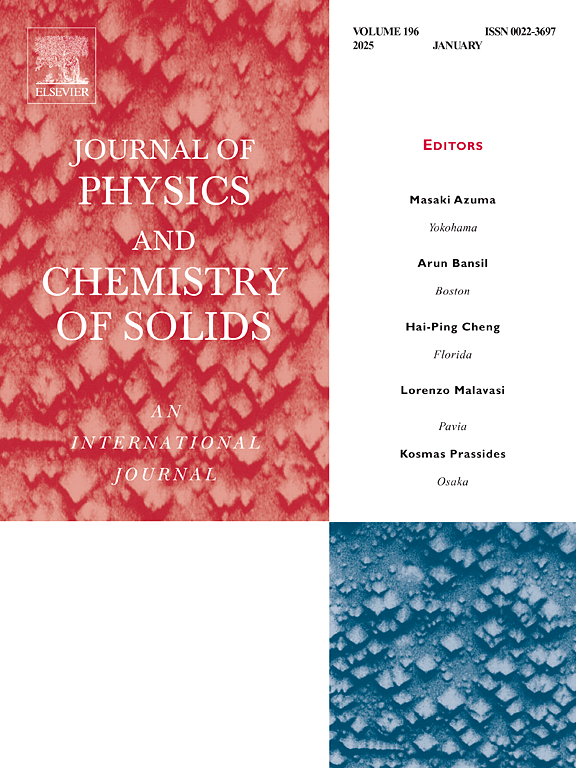Development and enhancement of charge separation processes for the degradation of RhB using an innovative ZnO/MgIn2S4 S-scheme heterojunction photocatalyst
IF 4.9
3区 材料科学
Q2 CHEMISTRY, MULTIDISCIPLINARY
引用次数: 0
Abstract
The dye Rhodamine B (RhB), commonly utilized in the textile sector, is linked to carcinogenic and neurotoxic effects, posing a significant risk for a range of human health issues. Photocatalytic systems can be used as an effective and energy-saving technique to degrade dye pollutants. Herein, a novel ZnO/MgIn2S4 S-scheme heterojunction photocatalyst was successfully synthesized by a facile method and employed as a highly efficient photocatalyst for the degradation of RhB under visible light irradiation. To optimize the use of the developed photocatalyst for environmental remediation, it was investigated how several factors affect the photocatalytic process. These factors included the initial pH of the reaction medium, the photocatalyst dosage, and RhB concentration. The reaction kinetics of the synthesized photocatalysts followed pseudo-first-order kinetics, and the degradation rate constant was obtained at 1874 × 10−4 min−1 for the optimized ZnO/MgIn2S4 nanocomposite, which was significantly increased compared to the constituent components. Examination of the optical properties demonstrated that the presence of MgIn2S4 with a narrow band gap increased the absorption of visible light in the nanocomposite compared to the bare ZnO. Also, photocurrent and electrochemical impedance studies displayed that, the incorporation of MgIn2S4 and ZnO facilitated charge separation by controlling the band structure in the constructed heterojunction. The trapping tests identified holes, hydroxyl and superoxide ion radicals as the dominant active species for photodegradation. In addition, the prepared ZnO/MgIn2S4 photocatalyst showed significant stability after 4 cycles of the photocatalytic degradation process. Finally, the most probable charge transfer mechanism was proposed by analyzing the experimental results.

利用创新的ZnO/MgIn2S4 S-scheme异质结光催化剂开发和增强降解RhB的电荷分离工艺
染料罗丹明B (RhB)通常用于纺织部门,与致癌和神经毒性作用有关,对一系列人类健康问题构成重大风险。光催化系统是一种高效节能的降解染料污染物的技术。本文采用简便的方法合成了一种新型ZnO/MgIn2S4 s型异质结光催化剂,并将其作为可见光下高效降解RhB的光催化剂。为了优化所开发的光催化剂在环境修复中的应用,研究了影响光催化过程的几个因素。这些因素包括反应介质的初始pH、光催化剂的用量和RhB的浓度。合成的光催化剂的反应动力学符合准一级动力学,优化后的ZnO/MgIn2S4纳米复合材料的降解速率常数为1874 × 10−4 min−1,与组成组分相比,降解速率显著提高。光学性质测试表明,与裸ZnO相比,窄带隙MgIn2S4的存在增加了纳米复合材料对可见光的吸收。此外,光电流和电化学阻抗研究表明,MgIn2S4和ZnO的掺入通过控制异质结中的能带结构促进电荷分离。捕集试验确定空穴、羟基和超氧离子自由基是光降解的主要活性物质。此外,制备的ZnO/MgIn2S4光催化剂在经过4次光催化降解过程后,表现出明显的稳定性。最后,通过对实验结果的分析,提出了最可能的电荷转移机理。
本文章由计算机程序翻译,如有差异,请以英文原文为准。
求助全文
约1分钟内获得全文
求助全文
来源期刊
CiteScore
7.80
自引率
2.50%
发文量
605
审稿时长
40 days
期刊介绍:
The Journal of Physics and Chemistry of Solids is a well-established international medium for publication of archival research in condensed matter and materials sciences. Areas of interest broadly include experimental and theoretical research on electronic, magnetic, spectroscopic and structural properties as well as the statistical mechanics and thermodynamics of materials. The focus is on gaining physical and chemical insight into the properties and potential applications of condensed matter systems.
Within the broad scope of the journal, beyond regular contributions, the editors have identified submissions in the following areas of physics and chemistry of solids to be of special current interest to the journal:
Low-dimensional systems
Exotic states of quantum electron matter including topological phases
Energy conversion and storage
Interfaces, nanoparticles and catalysts.

 求助内容:
求助内容: 应助结果提醒方式:
应助结果提醒方式:


